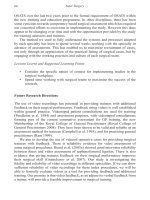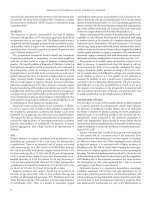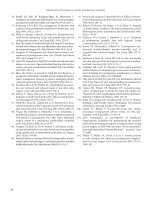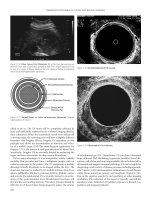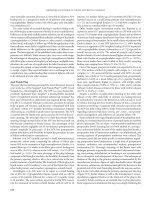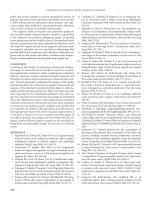Otosclerosis and Stapes Surgery - part 10 ppt
Bạn đang xem bản rút gọn của tài liệu. Xem và tải ngay bản đầy đủ của tài liệu tại đây (1.03 MB, 39 trang )
A Prospective Multicentre Otology Database 339
Ownership of the Data
Only validated data in the level II database will be used for research studies. The col-
lective data will remain the ownership of all the members who contributed to the level II
database.
Possible Clinical or Commercial Exploitation
The network of otologists within Europe could provide a powerful vehicle
for academic departments or commercial companies to run clinical trials.
Because of the potential number of centres that can collaborate in a clinical
trial, the result could be available within a shorter time frame. It is estimated
that 2,000 new cases will be entered into the database each year from the UK
and Europe.
Reference
1 Marquet J, Graff A: Post-operative evaluation of middle ear surgery. Audiology 1982;21:20–32.
Matthew Yung, PhD, FRCS
Department of Otolaryngology
The Ipswich Hospital NHS Trust, Heath Road
Ipswich, IP5 4PD (UK)
Tel. ϩ44 1473 703 527, Fax ϩ44 1473 703 576, E-Mail
Arnold W, Häusler R (eds): Otosclerosis and Stapes Surgery.
Adv Otorhinolaryngol. Basel, Karger, 2007, vol 65, pp 340–342
Stapes Surgery – Outcome Evaluation
Preliminary Results
E.A. Myrvoll, N.C. Stenklev, E. Laukli
ENT Department, University Hospital of Tromsø, Tromsø, Norway
Abstract
23 patients were studied preoperatively, 17 at 2 months and 11 at 6 months. Using cutoff at
30 dB HL (air-conduction), 2-month success rate was 5 of 17 patients (PTA: 0.5-1-2-4 kHz), 7 of
17 (PTA: 0.5-1-2-3 kHz), 9 of 17 (PTA: 0.5-1-2 kHz) and 15 of 17 (SRT: Speech recognition
threshold). At 6 months, success rate was 6 of 11 patients (PTA: 0.5-1-2kHz), 7 of 11 (PTA: 0.5-
1-2-3 kHz), 8 of 11 (PTA: 0.5-1-2 kHz) and 10 of 11 (SRT). When evaluating 6-month outcome
by air-conduction measures, the highest success rates (91%) after stapes surgery were seen using
SRT, and lowest (55%) using the 4-frequency average PTA: 0.5-1-2-4 kHz.
Copyright © 2007 S. Karger AG, Basel
There are different ways of assessing outcome after stapes surgery. The
outcome in a given clinical population can vary according to the method that is
chosen for outcome assessment. Traditionally, postoperative closure of the air-
bone gap (ABG) at the frequencies 0.5, 1 and 2 kHz has been used for reporting
postoperative results [pure-tone average (PTA) at 0.5, 1, 2 kHz].
We evaluated all but 2 patients who had undergone stapedotomy in our
Department from October 2002 until December 2003. The patients were tested
preoperatively, and 2 and 6 months postoperatively. We did the following tests:
pure-tone audiometry for air and bone conduction, two-syllabic speech audio-
metry for air and bone conduction and transient evoked otoacoustic emissions.
Audiometric tests were done using a Madsen audiometer (Orbiter 92 vs. 2
with Sennheiser HDA 200 circumaural earphones), with a frontally located
Radioear B-71 bone conductor. The audiometer was calibrated according to
current ISO standards.
So far, we have examined 24 patients preoperatively, 23 at 2 months and 16 at
6 months postoperatively. The results in table 1 apply to air conduction audiometry.
Stapes Surgery – Outcome Evaluation 341
After 2 months, we had the following results: PTA (0.5, 1, 2 kHz) of 30 dB
HL or better in 12 of 23 patients; PTA (0.5, 1, 2, 3 kHz) of 30 dB HL or better
in 10 of 23 patients; PTA (0.5, 1, 2, 4 kHz) of 30 dB HL or better in 8 of 23
patients; speech recognition threshold (SRT) of 30 dB HL or better in 19 of 23
patients; ABG (0.5, 1, 2, 3 kHz) of 10 dB HL or better in 14 of 23 patents, and
ABG (0.5, 1, 2, 3 kHz) of 20 dB HL or better in 22 of 23 patients.
After 6 months, the results were as follows: PTA (0.5, 1, 2 kHz) of 30dB HL
or better in 12 of 16 patients; PTA (0.5, 1, 2, 3 kHz) of 30 dB HL or better in 9 of
16 patients; PTA (0.5, 1, 2, 4 kHz) of 30 dB HL or better in 9 of 16 patients; SRT
of 30 dB HL or better in 15 of 16 patients; ABG (0.5, 1, 2, 3 kHz) of 10 dB HL or
better in 5 of 16 patents, and ABG (0.5, 1, 2, 3kHz) of 20 dB HL or better in 15 of
16 patients. At 6 months, we asked the patients if they were satisfied with the out-
come of the operation: 14 out of 16 were satisfied and 2 did not respond.
We compared our results with a study of stapes surgery outcome conducted
by Mair [1] in Tromsø in 1989. The results are presented in table 2. We believe
the results are comparable, although the preoperative/postoperative differences
Table 1. Mean air conduction thresholds preoperatively and postopera-
tively after 2 and 6 months (dB HL)
Preoperatively After 2 months After 6 months
24 23 16
SRT 38.5 20.6 17.3
PTA (0.5, 1, 2 kHz) 50.6 29.7 28.3
PTA (0.5, 1, 2, 3 kHz) 50.4 31.4 30.2
PTA (0.5, 1, 2, 4 kHz) 50.0 32.7 30.9
Table 2. Mean differences between pre- and postoperative air conduc-
tion thresholds (dB HL)
Mair [1] Our study
128 16
0.25 kHz 30.8 (18.7) 29.3 (13.6)
0.5 kHz 32.1 (16.3) 29.0 (14.4)
1 kHz 28.7 (17.4) 26.7 (17.2)
2 kHz 22.7 (18.0) 19.0 (12.3)
4 kHz 14.7 (20.7) 12.7 (19.4)
8 kHz 0.3 (23.7) 0.0 (16.6)
Standard deviations are in parentheses.
Myrvoll/Stenklev/Laukli 342
were larger in Mair’s study. The standard deviations were also larger in his study,
reflecting greater heterogeneity of the results. Furthermore, his number of
patients was higher than ours, the follow-up time longer and the technique was
different (i.e. stapedectomy was performed) in a sizeable proportion of subjects.
When outcome is evaluated using air conduction audiometric thresholds,
the highest success rates after stapes surgery were seen using SRT. (An even
higher success rate was found for an ABG of 20dB HL or less, although we do
not consider this outcome to be a valid criterion for successful stapes surgery.)
An ABG at the frequencies 0.5, 1, 2, 4 kHz of Ն10 dB HL yields the poorest
results. The most appropriate parameter for reporting outcome after stapes
surgery remains a subject of discussion [2]. Although the choice of outcome
criteria should reflect the patients’ functional hearing, simply asking the
patients about their postoperative hearing may be of limited value.
References
1 Mair IW: Occasional stapes surgery – A Norwegian experience. J Laryngol Otol 1989;103:259–262.
2 Berliner KI, Doyle KJ, Goldenberg RA: Reporting operative hearing results in stapes surgery:
does choice of outcome measure make a difference? Am J Otol 1996;17:521–528.
Elin A. Myrvoll
ENT Department, University Hospital
PO Box 34
NO–9038 Tromsø (Norway)
Tel. ϩ47 77 62 73 90, Fax ϩ47 77 62 73 69, E-Mail
Arnold W, Häusler R (eds): Otosclerosis and Stapes Surgery.
Adv Otorhinolaryngol. Basel, Karger, 2007, vol 65, pp 343–347
How Does Stapes Surgery Influence
Severe Disabling Tinnitus in
Otosclerosis Patients?
Carlos A. Oliveira
Department of Otolaryngology, Brasília University Medical School,
Brasília, Brazil
Abstract
Tinnitus is a common symptom in otosclerosis patients. Many papers have been written
about tinnitus outcome after stapes surgery. However, none has attempted to quantify the
intensity of the symptom pre- and postoperatively in order to evaluate the influence of
surgery on the degree of annoyance caused by tinnitus. Severe disabling tinnitus (SDT) is
defined by Shulman as a symptom severe enough to disrupt the patient’s routine and to pre-
vent him from performing his daily tasks. We have studied 48 consecutive otosclerosis
patients by means of a visual analogue scale measuring tinnitus intensity before and after
stapes surgery. We have accepted tinnitus as severe and disabling when the symptom score
was 7 or above in a visual analogue scale from 1 to 10. Of 19 patients with preoperative SDT,
10 reported complete remission and 7 reported significant improvement. Two patients had no
change and none reported worsening of tinnitus after stapes surgery. We conclude that stapes
surgery can improve SDT significantly in 90% of otosclerosis patients and is very unlikely to
make the symptom worse.
Copyright © 2007 S. Karger AG, Basel
Many papers have been written about tinnitus outcome after stapes surgery
in otosclerosis patients [1–8]. These articles have measured tinnitus pitch pre-
and postoperatively, but none have measured tinnitus intensity before and after
stapes surgery.
In 1953, Heller and Bergman [9] showed that over 90% of normal-hearing
people reported tinnitus when placed in a soundproof cabin. However, the
symptom did not cause any discomfort to those patients in daily life. Being so,
it becomes necessary to separate common garden variety tinnitus from serious,
disrupting ones.
Oliveira 344
Shulman [10] coined the term severe disabling tinnitus (SDT) for a symp-
tom that is severe enough to disrupt the patient’s routine and to keep him from
performing his daily tasks. Usually, this kind of patient seeks medical attention
because of his tinnitus, while in less severe cases the symptom is mentioned
during medical consultation for other problems.
Tinnitus is certainly very common among otosclerosis patients; some of
them report very intense annoyance from the symptom and ask what will hap-
pen to the symptom after stapes surgery.
We tried to quantify the intensity of tinnitus in otosclerosis patients pre-
and postoperatively by means of a visual analogue scale (VAS) going from 1
(very low intensity) to 10 (unbearable intensity). We considered SDT as having
an intensity of 7–10 on the VAS. By comparing the tinnitus score before and
after stapes surgery for otosclerosis, we tried to determine the influence of the
surgical procedure on SDT. The results of this study are reported below.
Materials and Methods
This is a prospective study. We applied a VAS, in which 1 meant a very low intensity
and 10 an unbearable intensity for the symptom of tinnitus, to 48 consecutive otosclerosis
patients before and after stapes surgery. We considered SDT as yielding a score of 7 or above
on the VAS.
In all patients, pure-tone audiometry and a word discrimination test were performed
pre- and postoperatively.
Forty-four patients underwent stapedotomy and 4 stapedectomy. Hearing results were
evaluated by comparing the pre- and postoperative four-tone average air-bone gaps. The
influence of surgery on SDT was measured by comparing pre- and postoperative scores for
the symptom on the VAS. The operative notes were carefully reviewed for any problem
occurring during surgery.
The VAS was applied 4–10 months after surgery. We considered significant a score
improvement of Ն2 points on the VAS. Twenty-five patients were contacted 14–48 months
after surgery and were asked about the tinnitus status at this late follow-up time.
The protocol was approved by the ethics committee on research involving human sub-
jects of our institution.
Results
There were 29 female and 19 male patients. Forty-four of the 48 patients
reported tinnitus preoperatively (91.6%). Mean age was 44.5 years (range 16–62).
SDT was present in 19 patients preoperatively (39.6%) and female patients
tended to report more SDT than male counterparts (55.5% of female and 15.8%
of male patients).
Influence of Stapes Surgery on SDT 345
Overall 40 (90.9%) tinnitus patients reported postoperative improvement
and 4 (9.09%) noted no change in tinnitus. None said the symptom was worse.
Table 1 shows postoperative tinnitus outcome of the 19 SDT patients. Ten
of the 19 tinnitus patients reported total remission of tinnitus after surgery and
6 had a significant improvement (at least 2 points on the VAS). One reported a
slight improvement and 2 noted no change in the symptom.
The intensity of preoperative tinnitus was not related to the preoperative
air-bone gap (mean air-bone gap of 34.3 dB for SDT and 31.4dB for less
intense tinnitus). However, larger preoperative air-bone gaps seemed to predict
better postoperative improvement in SDT (table 2) when a good hearing result
was achieved. Smaller postoperative air-bone gaps correlated with more remis-
sion and improvement of SDT postoperatively (table 3).
Patients with SDT 19
Total remission 10 (52.6)
Significant improvement 6 (31.7)
Slight improvement 1 (5.2)
No change 2 (10.4)
Figures in parentheses indicate percentages.
Table 1. SDT: postoperative outcome
Table 2. Preoperative air-bone gap and postoperative SDT remission
Preoperative air-bone gap in patients with SDT n Total remission
Ͼ30 dB 14 8 (57.14)
Ͻ30 dB 5 2 (40.0)
Figures in parentheses indicate percentages.
Table 3. Postoperative air-bone gap and SDT
Air-bone gap n Total Significant Slight No
remission improvement improvement improvement
0–20 dB 17 (89.46) 9 (52.9) 7 (41.2) 0 1 (5.84)
Ͼ20 dB 2 (10.52) 0 0 1 (50) 1 (50)
Figures in parentheses indicate percentages.
Oliveira 346
There was a trend for lower preoperative bone conduction levels to corre-
late with preoperative SDT (44.1% of patients with a four-tone average bone
conduction level below 40 dB had preoperative SDT while 28.5% of patients
with a preoperative four-tone average bone conduction level above 40 dB had
SDT).
Twenty-five patients (7 SDT) contacted 14–48 months after surgery said
their tinnitus status had not changed since surgery.
There were no untoward events during surgery and no postoperative com-
plications other than 6 patients with an air-bone gap above 20 dB were seen.
Comments
In 1999, Oliveira et al. [11] applied a tinnitus questionnaire that included a
VAS to all new patients seen at the Otology Clinic of the Brasília University
Hospital for a 6-month period of time. Five hundred tinnitus patients were iden-
tified. These patients had presbycusis, chronic otitis media, otosclerosis,
acoustic trauma, Ménière’s disease, ototoxicity and vestibular schwannoma in
this order of frequency. However, 81% of the tinnitus patients had a very mild
symptom and only mentioned tinnitus because they were asked about it.
Eighteen percent had a mild symptom they could tolerate well or were easily
relieved with routine medical treatment. Only 1% had tinnitus that was very
intense (above 7 on the VAS), disrupting the patients’ routine, and they were
refractory to medical treatment (central vasodilators, vestibular suppressants,
calcium channel blockers, anticholinergics, anticonvulsants). To sum up, tinni-
tus is a very common symptom among patients of an otology clinic but only 1%
of these patients have SDT.
Otosclerosis was the 3rd most frequent diagnosis listed above and we have
found an incidence of tinnitus (91.6%) in our 48 otosclerosis patients similar to
the one in the general population [9]. However, 39.6% of our otosclerosis
patients had SDT as compared to 1% in the patients of our otology clinic.
Therefore, otosclerosis seems to be strongly associated with SDT.
Otosclerosis patients who have SDT are the ones who always ask the doc-
tor what will happen to their tinnitus after stapes surgery and often mention tin-
nitus relief as their priority. Because all papers published up to now [1–8] had
not targeted SDT, we undertook the present study.
Our results allow the following statements:
(1) Otosclerosis is a major cause for SDT. How the otosclerosis process leads
to severe tinnitus remains to be clarified.
(2) Stapes surgery (namely stapedotomy, because 44 of our 48 patients had
this operation performed) can totally relieve SDT in roughly 50% of cases
Influence of Stapes Surgery on SDT 347
and significantly improve another 31%. About 10.4% of SDT patients will
not have any relief after stapes surgery. These patients probably have
already developed a paradoxical memory in the medial temporal lobe sys-
tem as proposed by Shulman et al. [10] and will not respond to any treat-
ment of the peripheral organ.
(3) Because larger air-bone gaps preoperatively predict better tinnitus
improvement when the stapes surgery results in smaller postoperative air-
bone gaps (tables 2 and 3), we suggest that the masking effect produced by
better postoperative hearing is probably responsible for the tinnitus
improvement.
(4) Since 25 tinnitus patients (7 SDT) contacted up to 48 months after surgery
said their tinnitus status had not changed compared to the early follow-up
situation, it is safe to say that the influence of stapes surgery on SDT in
otosclerosis patients is long-lasting.
(5) Worsening of SDT after stapes surgery is unlikely provided an atraumatic
procedure was performed.
References
1 Shea JJ: Otosclerosis and tinnitus. J Laryngol Otol Suppl 1981;4:149–150.
2 Shea JJ, Orchik DJ: Endolymphatic hydrops associated with otosclerosis. Am J Otol
1994;15:348–357.
3 Causse JB, Vincent R: Poor vibration of inner ear fluids as a cause of low tone tinnitus. Am J Otol
1995;16:701–702.
4 Ramsay H, Karkainem J, Palva T: Success in surgery for otosclerosis: hearing improvement and
other indicators. Am J Otolaryngol 1997;18:23–28.
5 Ayache D, Earally F, Elbaz P: Characteristics and postoperative course of tinnitus in otosclerosis.
Otol Neurotol 2003;24:48–51.
6 Gersdorff M, Nowen J, Gilain C, Decat M, Betsch C: Tinnitus and otosclerosis. Eur Arch
Otorhinolaryngol 2000;257:314–316.
7 Szymansky M, Golabek W, Mills R: Effect of stapedectomy on subjective tinnitus. J Laryngol
2003;117:261–264.
8 Gristwood RE, Venables WN: Otosclerosis and chronic tinnitus. Ann Otol Rhinol Laryngol
2003;112:398–403.
9 Heller MF, Bergman M: Tinnitus aurium in normally hearing persons. Ann Otol Rhinol Laryngol
1953;62:73–83.
10 Shulman A, Strashun, AM, Ariye M, Aronson F, Abel W, Goldstein B: SPECT imaging of brain
and tinnitus: neurotologic/neurologic implications. Int Tinnitus J 1995;1:13–19.
11 Oliveira C, Venosa A, Araujo MF: Tinnitus program at Brasília University Medical School. Int
Tinnitus J 1999;5:141–143.
Carlos A. Oliveira, MD, PhD
SHIS QL-22 Conjunto-4 Casa-9
Brasília, DF 71650-245 (Brazil)
Tel. ϩ55 61 245 1833, Fax ϩ55 61 346 3772
Arnold W, Häusler R (eds): Otosclerosis and Stapes Surgery.
Adv Otorhinolaryngol. Basel, Karger, 2007, vol 65, pp 348–352
Patients’ Lives following
Stapedectomy Complications
Jean-Philippe Guyot, Kenan Sakbani
Department of Otorhinolaryngology, Head and Neck Surgery,
University Hospital, Geneva, Switzerland
Abstract
Nowadays, it is widely accepted that patients must be informed about the risks associ-
ated with any type of surgical procedure. Usually, the information provided consists of quot-
ing a list of risks and their probability of occurrence based on data from the literature, and,
more appropriately, the figures reflecting the surgeon’s personal experience. As a rule, such
data are sufficient to hold up in court in the event of a lawsuit, but may be insufficient to help
patients make the most appropriate choice. We report two cases that presented complications
following stapedotomy. Both cases had a sensorineural hearing loss and a vestibular deficit.
This paper aims at describing the important psychological and social consequences of these
complications. The potential impact of such complications on the quality of life and the pro-
jects for the future of these young patients was predictable. In order to better assist patients in
choosing amongst options, we have taken action and modified our approach in advising our
patients eligible for stapedotomy procedures.
Copyright © 2007 S. Karger AG, Basel
The efficiency of the surgical techniques used for the correction of the
conductive hearing loss caused by otosclerosis, the so-called stapedectomy [1]
or stapedotomy [2], has been extensively reported in the literature: the benefits
of the procedure can be quantified in terms of hearing gain [3, 4] as well as
improvement in quality of life [5]. Complications are rare, consisting of a sen-
sorineural hearing loss, vertigo or imbalance, dysgeusia, facial nerve paralysis,
or meningitis. Sensorineural hearing loss may be immediate or delayed. The
rate varies among series between 0 and 7% (mean: 0.9%) [3]. Whilst transitory
postoperative vertigo is often reported as a complication, persistent imbalance
Life following Stapedectomy Complications 349
resulting from a total vestibular loss is not even mentioned in some papers and
occurs in up to 7% in others [6]. The cause of these deficits is unknown and
therefore such complications may occur in any center! The other complications
are much rarer, and generally result from surgical technique defaults.
In general, the preoperative counseling of the patient consists of quoting a
list of benefits as well as risks and their probability of occurrence. The infor-
mation is based on data from the literature or more appropriately, on figures
reflecting the surgeon’s own experience. As a rule, such data are sufficient to
hold up in court in the event of a lawsuit, but may be insufficient to help
patients make the most appropriate choice.
The purpose of this paper was to describe the psychological and social
consequences of a total loss of auditory and vestibular function following
stapes surgery in 2 patients, and to critically review the way to better assist
patients eligible for stapedotomy procedures in choosing amongst options.
Case Report
Case 1
A 48-year-old male was referred to our department with a progressive left hearing loss.
He was a native of Portugal and had been living in Geneva for 10 years, working in a large
company as a bricklayer. Otoscopy was normal. The Weber test was lateralized to the left, the
Rinne negative on the left. The pure-tone audiogram showed a 40-dB left conductive hearing
loss, and the stapedial reflex was absent except to the right in response to an ipsilateral stim-
ulation. On March 6, 1998, the patient underwent a stapedotomy. The procedure was stan-
dard, as described by Schuknecht [7]. It was performed as an outpatient procedure, under
local anesthesia and using a transcanal approach through the ear speculum. A posterior tym-
panomeatal flap was elevated, the stapedius tendon cut, and the crural arch fractured and
removed. A 0.8-mm perforation of the footplate was carried out with a motor-driven sharp-
cutting bur, and a 0.6-mm Teflon wire piston inserted. The oval window was sealed with a
piece of perilobar fat tissue. The tympanomeatal flap was replaced and the external ear
packed with silk strips and cotton soaked in neomycin, polymyxin and hydrocortisone
(Corticosporin
®
). The procedure was uneventful.
Three days after surgery, the patient experienced a violent vertigo of sudden onset.
Clinical examination revealed a spontaneous right-beating nystagmus. The packing was
removed. There was complete hearing loss. The surgical exploration showed no displacement
of the prosthesis, and no abnormal middle ear tissue. Four weeks after revision surgery, the
patient mentioned he was having nightmares and could not sleep well. He was obviously suf-
fering from an acute depressive episode. He was referred to a psychiatrist who diagnosed the
resurgence of a past psychological disorder in reaction to the horrors the patient had wit-
nessed as a soldier during the war in Angola, back in the seventies. Vertigo gradually sub-
sided over months. Unfortunately, there was no hearing recovery. A 2-year psychological
treatment was necessary to improve the mood of the patient.
Guyot/Sakbani 350
Case 2
A 37-year-old male was seen 6 months after a stapedotomy complicated by a
cochleovestibular deficit. He was suffering from a progressive bilateral hearing loss. He was
an electronic engineer, working as technical vice director of a small company. He was plan-
ning to create his own company in the near future, and wanted the operation in order to facil-
itate communication with his future employees. On October 1, 2001, he underwent a left
stapedotomy, by a renowned otologist. Surgery was performed as an outpatient procedure,
under local anesthesia and through the external auditory canal. According to the patient and
the documents we had access to, the procedure was uneventful.
Four days after surgery, the patient experienced an intense rotatory vertigo with nausea
and vomiting. He refused surgical exploration of the ear and was given oral corticosteroids
for 5 days. The vertigo gradually subsided in 4–5 days but the patient noticed a total loss
of hearing and a persisting imbalance. He was able to return to work only 6 months after
surgery.
At the last visit, 3 years after surgery, there is no hearing recovery, and a slight imbal-
ance persists. The patient wears a hearing aid on the contralateral ear. He complains of
intense fatigue and considers himself inefficient at work. He was downgraded from vice
director to employee, with obvious financial consequences. His project to start his own com-
pany is definitely cancelled. In his own words, his life has been radically changed by the
surgery. He states the obvious negative impacts, but also positive aspects such as a reduction
of his ambient stress that resulted from the decrease in his ambitions.
Discussion
These cases illustrate that patients’ lives may require radical modifications
due to stapedectomy complications. The first case demonstrates how vertigo is
a frightening experience. Vertigo weakens patients physically and mentally,
allowing the reactivation of sometimes already successfully treated past psy-
chological disorders. This has been shown in many other instances, in particular
in large series of patients suffering from Ménière’s disease [8, 9]. The second
case illustrates that the complications of stapedectomy have sometimes major
professional and financial consequences. Although in the long run patients
cope with the new physical condition, it is at the price of a tremendous effort in
professional, family, mental, and emotional adaptation, the result of surgery
being the opposite of the expectation, a hearing loss rather than gain and per-
sisting imbalance!
In 1998, a debate on the ethics of stapedectomy was published [10–16].
As wearing a hearing aid would give functional results comparable to those
achieved by surgery, when should surgery be performed? Due to the risks of
serious complications, all the authors considered stapedectomy ethical after the
patient has given a fully informed consent, one adding that patients should
undergo surgery only after a trial of hearing aid use [10]. However, the risk of
persisting imbalance was not even mentioned in this debate, which raises the
Life following Stapedectomy Complications 351
question on the definition of an informed consent! Knowing every possible out-
come, would our patients have chosen surgery over a hearing aid?
Eriksson-Mangold et al. [17] have shown that patients confronted with the
significant impact of stapes surgery on their life report conflicting feelings
of both added responsibility and anxiety, resulting in emotional turmoil. Their
choice between a hearing aid versus surgery is thus based on rational, but also
many irrational considerations. Indeed, patients may choose an operation to
make others aware that the situation is serious and to gain sympathy, which
‘may promote adaptation to the handicap’, or to the contrary, ‘impede adapta-
tion to the necessary hearing aids’ [17]. The opinions of the people in contact
with the patient are important, as hearing deficit is the single greatest handicap
in communicating with others [Degive, C., pers. commun.]. In the population,
deafness is associated with mental deficiency, and hearing aids with aging
and/or poor communication. Obviously, wearing a hearing aid makes the hand-
icap visible. In spite of this, we think that it is also the responsibility of sur-
geons to promote nonsurgical solutions to a problem. In addition, from an
ethical point of view, to dispel preconceptions about hearing aids is also the
role of doctors. As a consequence, today, our patients are clearly informed of
all the benefits and risks of the operation, and informed that a hearing aid
would provide satisfactory results. Finally, a period is given for them to fully
assimilate the information, which appears essential before a proper decision
can be made.
Many doctors consider that information regarding the benefits and risks of
an operation is given to the patients in order to hold up in court in the event of a
lawsuit [11]. Such a conception weakens the patient-doctor relationship as the
physician’s role is reduced to merely implementing a treatment with a looming
threat of punishment in case of problems, whereas the lawyer’s role is elevated,
as he establishes the rules and controls their application. Conversely, if the
information is dispensed with the intention of helping the patient choose the
best course of action, the patient-doctor relationship is strengthened as
the responsibility is evenly shared between both actors. The trust thus forged
would certainly diminish the number of lawsuits [18], which have a negative
impact on not only the surgeon, but also the patient who, due to the length of the
proceedings, takes a longer time to accept the functional loss, and often goes as
far as presenting a major depressive event.
As a renowned myopic surgeon, would you accept an operation to cure
your myopia which presents as little as a one-percent chance of total visual loss,
or wear glasses? And what information would you need to make your choice?
These are the kinds of questions we have in mind when giving information to a
patient suffering from otosclerosis with a conductive hearing loss, being a can-
didate for a stapedotomy.
Guyot/Sakbani 352
Acknowledgments
The authors are grateful to Colette Degive, Psychologist, Department of Psychiatry,
and Prof. Alex Mauron, Chair of Ethics, University Hospital, Geneva, Switzerland, for their
assistance in preparing the manuscript.
References
1 Shuknecht HF, McGee TM, Colman BH: Stapedectomy. Ann Otol Rhinol Laryngol 1960;69:
597–609.
2 Shuknecht HF, Applebaum EL: Surgery for hearing loss. N Engl J Med 1969;280:1154–1160.
3 Häusler R: Advances in surgery; in Jahnke K (ed): Middle Ear Surgery. Stuttgart, Thieme, 2004,
pp 95–139.
4 Kos MI, Montandon PB, Guyot JP: Short- and long-term results after stapes surgery for otosclero-
sis with Teflon-wire piston prosthesis. Ann Otol Rhinol Laryngol 2001;110:907–911.
5 Aarnisalo AA, Vasama JP, Hopsu E, Ramsay H: Long-term hearing results after stapes surgery:
a 20-year follow-up. Otol Neurotol 2003;24:567–571.
6 Woldag K, Meister EF, Kosling S: Diagnosis in persistent vertigo after stapes surgery.
Laryngorhinootologie 1995;74:403–407.
7 Schuknecht HF: Otosclerosis surgery; in Nadol JB, Schuknecht HF (eds): Surgery of the Ear and
Temporal Bone. New York, Raven Press, 1993, pp 223–244.
8 Degive C, Archinard M, Kos MI, Guyot JPh: Interventions médico-psychothérapeutiques en ORL:
nouvelle approche pour les patients souffrant de la maladie de Ménière. ORL Nova 2000;10:
11–15.
9 Guyot JP, Degive C, Kos MI, Archinard M: Evaluation du handicap vestibulaire en consultation
conjointe médicopsychologique. Méd Hyg 2000;58:2086–2089.
10 Howard ML: Is stapedectomy ever ethical? Am J Otol 1998;19:541–543.
11 Shea JJ Jr: Is stapedectomy ever ethical? Am J Otol 1998;19:544–545.
12 Lundy LB: Ethics of stapedectomy. Am J Otol 1999;20:137–138.
13 Gauthier MG: Is stapedectomy ever ethical? Never say ‘ever’. Am J Otol 1999;20:138.
14 Gianoli GJ, Gonsoulin T, Amedee R, Tabb H, Mann W: Is stapedectomy ever ethical? Faulty
premise, faulty conclusion. Am J Otol 1999;20:138–140.
15 Miller MH: Is stapedectomy ever ethical? An audiologist replies. Am J Otol 1999;20:140–141.
16 Howard ML: Is stapedectomy ever ethical? Author’s reply. Am J Otol 1999;20:141.
17 Eriksson-Mangold M, Erlandsson SI, Jansson G: The subjective meaning of illness in severe oto-
sclerosis: a descriptive study in three steps based on focus group interview and written question-
naire. Scand Audiol Suppl 1996;43:34–44.
18 Kern EB: The preoperative discussion as a prelude to managing a complication. Commentary.
Arch Otolaryngol Head Neck Surg 2003;129:1163–1165.
Prof. Jean-Philippe Guyot, MD
Department of Otorhinolaryngology, Head and Neck Surgery, University Hospital
24, rue Micheli-du-Crest
CH–1211 Geneva 14 (Switzerland)
Tel. ϩ 41 22 372 82 42, Fax ϩ41 22 372 82 40, E-Mail
Arnold W, Häusler R (eds): Otosclerosis and Stapes Surgery.
Adv Otorhinolaryngol. Basel, Karger, 2007, vol 65, pp 353–360
Teaching Stapes Surgery
Pierre B. Montandon
Geneva, Switzerland
Abstract
This paper is a review of concepts and methods presented as a tribute to a great pioneer
and teacher, Harold Frederic Schuknecht. His book entitled Stapedectomy, published in
1971, is based on past experience of ‘6,200 stapedectomy operations over a period of 13
years’ and on experience gained from teaching the procedure to numerous residents and fel-
lows. His concepts are still valid and represent a solid base for teachers and students of this
elegant but precarious procedure.
Copyright © 2007 S. Karger AG, Basel
I am grateful to Harold Frederic Schuknecht who personally taught me
stapes surgery in 1967.
His textbook entitled Stapedectomy, published in 1971 [1], encompasses
all aspects of how to teach this procedure. This book is based on past experience
of ‘6,200 stapedectomy operations over a period of 13 years’, and on ‘experi-
ence gained from teaching the procedure to 60 residents and fellows’.
For Schuknecht, responsible teaching begins with long-term assessment of
the teacher’s own experiences and presentation of concepts.
‘Time has shown that stapedectomy, when performed on carefully selected
patients, by a skilled surgeon, can be expected to provide prolonged improve-
ment of hearing; however, with this procedure, as with all surgical procedures,
there are undesirable results. It is quite clear to me, that the incidence of com-
plications is closely related to the surgeon’s technical adaptness and experience
as well as to his understanding of the pathology and clinical manifestations of
otosclerosis.’ I would be very disappointed if this book were to be used as a
cookbook by the uninitiated surgeon pursuing his vested right to operate,
because he is licensed to do so.
The book is illustrated with numerous drawings that are as helpful for the
student as for the teacher. A selection of some of these drawings are shown to
Teaching of Stapes Surgery
Montandon 354
exemplify the methods and aesthetics praised by Harold F. Schuknecht
(figs. 1–9).
After training with Harold Schuknecht, I have also personally performed
and taught stapes surgery over a period of 30 years. It gave me the opportunity
Fig. 1. Harold B. Schuknecht wrote this teaching book in 1971.
Vascular
channels
Vestibule
Internal
auditory
canal
Fig. 2. Histopathological feature of otosclerosis.
Teaching Stapes Surgery 355
Bell-shaped
speculum
Operative
field
Speculum
holder
Direction
of
vision
Fingertip
grip
Fingertip
grip
Angled
handle
Bent wrist
Finger
support
Instruments
enter from
periphery
Speculum
holder
Fig. 3. Manipulation of microsurgical instruments for transcanal access to the middle ear.
to witness the short- and very long-term results of this procedure performed not
only by myself, but also by my students and others.
I came to the conclusion that stapes surgery is one of the most precarious
operations you can do in the ear.
Of all ear surgeries, some look extremely impressive, such as removal of
deep-seated cholesteatomas or tumors in the temporal bone, but of all of them,
stapedectomy is the most worrisome. It is elective, as otosclerosis is not a life-
threatening disease. The aim of the operation is to improve hearing. There is a
reasonable alternative: hearing aids. Although immediate and long-term results
are generally very satisfactory, complications do exist and can make the life of
the patients less enjoyable than before. Most of these complications can be cor-
rected but may require additional surgery. The most common are vertigo, recur-
ring conductive hearing loss, severe sensorineural hearing loss, tinnitus, loss of
taste, dry mouth and facial palsy.
Surgical techniques are well standardized and the operations can look easy
and elegant, particularly when shown on videotapes in meetings.
In reality, the anatomy of the ear is inconsistent and varies to such an
extent that stapes operations cannot really be standardized. It requires a perfect
Montandon 356
knowledge of all possible variations and a plastic three-dimensional mind
image on the part of the surgeon, at all times. The dehiscent facial nerve can
mask part of the stapes or run across the footplate. The oval window may be
very narrow. The shape of the ossicle can vary and the chorda tympani is almost
always in the way, although it should not be moved or stretched!
The current operations all rupture the perilymph compartment of the inner
ear and most leave in place a metallic or plastic foreign body. Recent research
has shown the extreme importance of inner ear homeostasis and the role of the
circulating fluids as defense mechanisms of the very fragile sensory cells of the
cochlea and the vestibular system.
Surgical rupture of this delicate system might well upset an essential
electrolyte balance!
Teaching stapedectomy or stapedotomy, or stapedoplasty or whatever you
want to call it, requires a great sense of responsibility to potential patients who
will be submitted to the procedure and to the surgical students who will attend
these patients and bear the burden of potential mishaps.
Tympanic
annulus
Manubrium
Flap
Round
window
niche
Bone
curette
Lation
IOE
Drum
elevator
Line of
incision
Cut stapedius
tendon
close to
pyramidal
eminence
Sickle
knipe
Skin
flap
Fig. 4. Adequate exposure is a prerequisite to successful stapes surgery.
Teaching Stapes Surgery 357
Crimper
Incus
Overhanging
bone
Corrective
maneuver
Area of
impingement
Conforming
prosthesis
Overhanging
facial
nerve
Poor
Possibly
adequateGood
Fig. 5. Crimping of the prosthesis and positioning of the piston are very important steps.
Gelfoam
Piston
Fig. 6. Length of the prosthesis and
sealing of the stapedotomy are essential
features.
Montandon 358
Manubrium
Lateral
process
Flap
Umbo
Umbo
Manubrium
Aditus
Epitympanic space
Incus
Malleus
Bony
bar
Wraparound
attachment
to manubrium
Fig. 7. How to overcome additional pathologies, such as malleus bony ankylosis.
Cochlear
duct
Marginal
bur hole
Floating
footplate
Depressed
and
floating
footplate
Fig. 8. How to extract a ‘floating’ footplate.
How should one teach stapes surgery? I suggest the following course of
action.
(1) The first prerequisite is to have a precise knowledge of the tempo-
ral bone anatomy, including all possible variations, and a clear understan-
ding of middle ear and inner ear physiology, histopathology and
physiopathology.
(2) Numerous procedures performed by an experienced surgeon should be
observed.
(3) An acute understanding of postoperative evolutions is imperative.
Therefore, many office consultations of postoperative controls need to be
attended.
Teaching Stapes Surgery 359
(4) Theoretical knowledge of how to remedy all possible surgical difficulties
and complications should be thoroughly understood.
(5) The surgeon should have an essential surgical ability coupled with mod-
esty and common sense not to overestimate his ability.
(6) Surgical technique should be mastered by practicing on model or cadaver
temporal bones.
(7) Previous experience of other surgical procedures in the temporal bone such
as myringoplasty, ossiculoplasty, mastoidectomy and canalplasty is recom-
mended.
(8) The particularities of each instrument (e.g. microscope, drills, laser)
should be known. The young surgeon should also know what to do if one is
missing or breaks down, where replacement parts are available or where
another complete replacement set of instruments is!
(9) The student will learn step by step during live operations performed by the
supervision of his teacher, first by doing local anesthesia, then opening the
middle ear, and so on, and only last placing the prosthesis himself. The
teacher must attend every single step.
(10) For his first procedures alone, the student should be assisted by the
best team of nurses and anesthesiologists, with the best set of instruments,
and the best microscope, until he can really master the procedure. The
Utricle
Vestibule
Round window
niche
Footplate
Prom
o
ntory
Utricular
macula
Prosthesis
too long
Fig. 9. A too long prosthesis may cause vertigo. How to shorten it.
Montandon 360
teacher should be available in a few minutes’ delay during the first ten
procedures.
A common problem in students from the university medical center is the
ease and comfort of having anything they need at ‘one’s beck and call’. In real-
ity, when they will be practicing in the smaller area center or back in their third
world country, conditions might be more precarious and only with real mastery
will they know how to handle the situation.
The teacher should remember that teaching in Medicine is teaching in a
field that constantly benefits from knew discoveries provided by basic research
and the availability of new updated technical tools.
Therefore, the teacher’s aim is not only to transmit his own experience, but
to prepare the students to access new developments and improvements with a
critical mind and eventually, achieve better results than the teacher himself.
Reference
1 Schuknecht HF: Stapedectomy. Boston, Little Brown, 1971.
Prof. Pierre Montandon
4, chemin Beau-Soleil
CH–1206 Geneva (Switzerland)
Fax ϩ41 22 346 55 10
Arnold W, Häusler R (eds): Otosclerosis and Stapes Surgery.
Adv Otorhinolaryngol. Basel, Karger, 2007, vol 65, pp 361–369
The Learning Curve in Stapes Surgery
and Its Implication for Training
M.W. Yung
a
, J. Oates
b
a
Department of Otolaryngology, The Ipswich Hospital NHS Trust, Ipswich,
b
Department of Otolaryngology, Queen’s Hospital, Burton Hospital’s NHS Trust,
Burton-on-Trent, UK
Abstract
Objective: To identify the ‘stapedotomy’ learning curve of 2 UK otolaryngologists.
Study Design: A retrospective review of the outcome of the first 100 stapedotomy opera-
tions by each surgeon. Included in the study was a postal survey of the incidence of stapes
surgery by UK otolaryngologists. Setting: Two tertiary referral centres. Patients: All ears
in which primary stapedotomy was performed for otosclerosis. Non-otosclerotic cases and
malleus stapedotomy cases were excluded. Intervention: One surgeon used the technique
of small fenestra stapedotomy with either a Teflon™ wire or titanium piston, but without
vein graft interposition, whilst the second employed the technique of stapedotomy with vein
graft interposition, and a Teflon™ piston. Main Outcome Measures: The first 100 stapes
operations performed by each surgeon were subdivided into consecutive groups of 10. Using
a postoperative air-bone gap of 20 dB or better as a definition of ‘success’, the ‘success rates’
of each group were plotted on graphs – the learning curves. The end point of the learning
curve was defined as the point ‘where the curve reaches its plateau’. Results: The learning
curves of both surgeons included 70–80 operations. Both surgeons had one ‘dead ear’ in their
first 15 cases. The postal survey showed that some trainers only perform a small number of
stapes surgeries, whereas some otolaryngologists who regularly perform stapedotomies were
not trainers. Conclusions: This is a mismatch of trainers and trainees in stapes surgery. If
the current trend of decline in stapes surgery continues, it will take many years for some oto-
laryngologists to complete their learning curves.
Copyright © 2007 S. Karger AG, Basel
Over the last 20 years, the number of stapes operations performed has
decreased steadily. Most of the backlog of patients with otosclerosis had
their surgery performed in the 1960s and 1970s. Other possible reasons for the
reduction could be the fluoridation of water supplies [1] and improvement of the
Yung/Oates 362
quality of hearing aids [2]. As the number of practising otolaryngologists steadily
increases, it is inevitable that fewer cases of otosclerosis present to each surgeon.
This inadequate exposure to stapes surgery poses problems for both trainees
and trainers. Many institutions reported concerns in the 1980s and 1990s that
hearing results for resident-performed stapedectomies were significantly worse
than those for experienced otologic surgeons [3–6]. The trainers of this period
were probably trained at the time when stapes surgery was still a common oper-
ation, i.e. during the 1960s and 1970s. With the declining number of stapes oper-
ations in the last 30 years, the lack of experience gained by trainees has led to the
inevitable consequence that as they progress to become trainers the majority of
trainers are relatively inexperienced when compared to ‘past masters’.
Some otolaryngologists only perform their first ‘complete’ stapes oper-
ation when they become consultants. It is natural that they go through a learn-
ing curve before they can achieve good results, let alone become a trainer in
stapes surgery. A previous report by Hughes [7] indicates that it took 50 stapes
operations for him to complete his learning curve. He defined the end point of
his learning curve to be a ‘10-dB or better postoperative air-bone gap in 90% of
patients’. Another report by Sargent [8] confirmed that his results of stapedo-
tomy improve with experience, although he did not specify how steep the learn-
ing curve was. Both authors went through the residency or fellowship training
in the USA.
The aim of this study was to compare the learning curves of 2 UK surgeons,
each using a different technique for stapes surgery. Both authors had completed
8 years of otolaryngology surgical training. In addition to that training, the first
author (M.W.Y.) had a further 6 months of fellowship training in otology.
Materials and Methods
National Survey on Stapes Surgery
A postal survey was sent to the members of the British Association of Otorhino-
laryngologists, Head and Neck Surgeons in 2001 to enquire about the number of stapes
operations they had performed during the previous 12 months. They were also asked whether
they had been involved in stapes surgery training for the higher surgical trainees.
Study of the Learning Curves
Ears
The audiometric results of the first 100 consecutive primary stapes operations from
each author (M.W.Y. and J.O.) were reviewed retrospectively. Revision cases, non-otoscle-
rotic cases and malleus stapedotomy cases were excluded.
Learning Curve of Stapedotomy 363
Surgical Techniques
There had been many minor modifications of the surgical techniques by both authors
throughout the years. However, the basic surgical procedure used by each author remained
unchanged. The first author (M.W.Y.) used the technique of small fenestra stapedotomy with-
out vein graft interposition. The operations were routinely performed under local anaesthe-
sia. The first 30 stapes operations were non-laser assisted but all the subsequent ones were
laser assisted using the argon or KTP laser. A Teflon™ wire or titanium piston was inserted
into a 0.6-mm hole on the footplate. The oval window was then sealed using connective tis-
sue plugs. For the first 44 cases, a stapes piston was used with a diameter of 0.6 mm. The
diameter was changed to 0.4mm in subsequent cases.
The second author (J.O.) used the technique of stapedotomy with vein graft interposi-
tion. The operation was performed under general anaesthesia and laser assisted using the
KTP laser in all cases. A piece of vein graft, harvested from the wrist or hand, was placed
over a 0.8-mm hole created in the stapes footplate and a 0.4-mm Causse Teflon Piston™ or a
Robinson Teflon™ ‘bucket handle’ prosthesis was used for reconstruction.
Audiometric Assessment
The pre- and postoperative air-bone gaps (at 6 months or longer) for each ear were
examined. The postoperative air-bone gap was calculated using postoperative bone conduc-
tion and postoperative air conduction thresholds. The 4-frequency average of 500, 1,000,
2,000 and 3,000Hz was used to calculate the mean hearing level on the ears as recommended
by the American Academy of Otolaryngology – Head and Neck Surgery’s Committee on
Hearing and Equilibrium [9].
Analysis
The hearing results of the first 100 ears operated by each author were analysed sepa-
rately. They were divided into small consecutive groups of 10 cases. The ‘success rates’ of
each small group were plotted on graphs – i.e. the learning curves of the individual authors.
These graphs showed the postoperative air-bone gaps and the percentage of ears with closure
of the postoperative air-bone gaps to within 10 and 15 dB. It was recognised that the post-
operative hearing results based on postoperative air-bone gaps may not identify those ears with
cochlear damage from the operation. Hence, ears with deterioration of the bone conduction
threshold of more than 20 dB were highlighted in each graph. The present authors defined
the end point of the learning curve as ‘when the curve reaches its plateau’.
Results
National Survey on Stapes Surgery
Five hundred and eighteen questionnaires were sent to the members of the
British Association of Otorhinolaryngologists, Head and Neck Surgeons. Of
these, 225 responded, giving a response rate of 43%. Ninety-six surgeons had
performed at least one stapes operation during the previous 12 months. The respon-
dents were divided into groups according to the number of stapes operations
